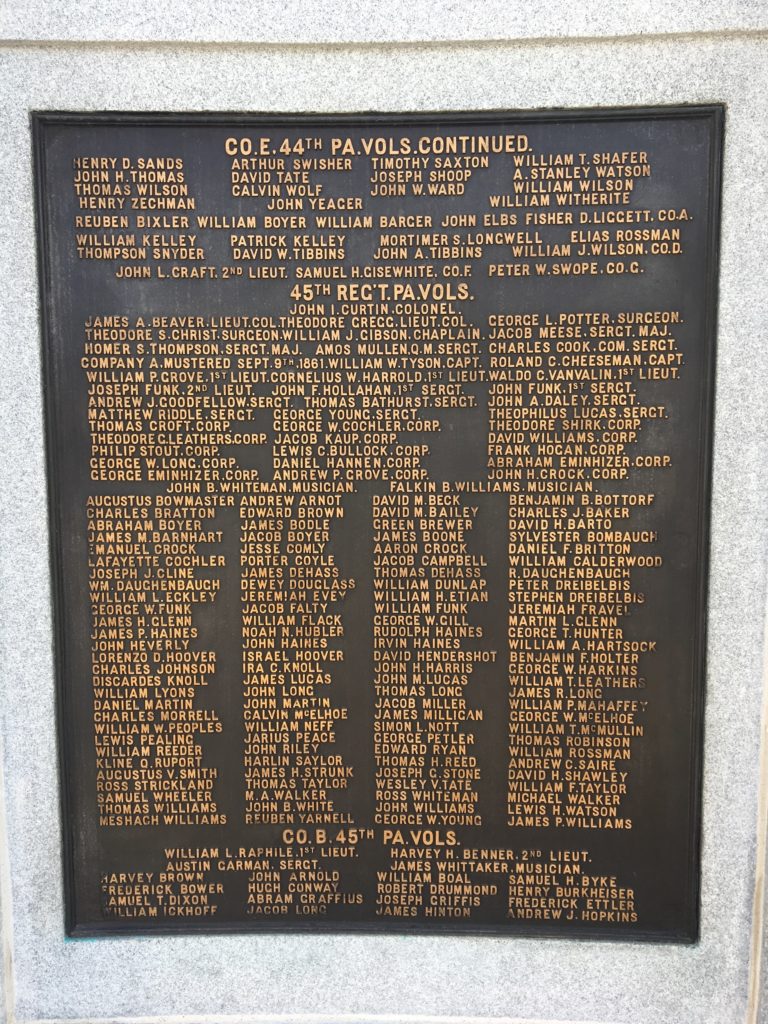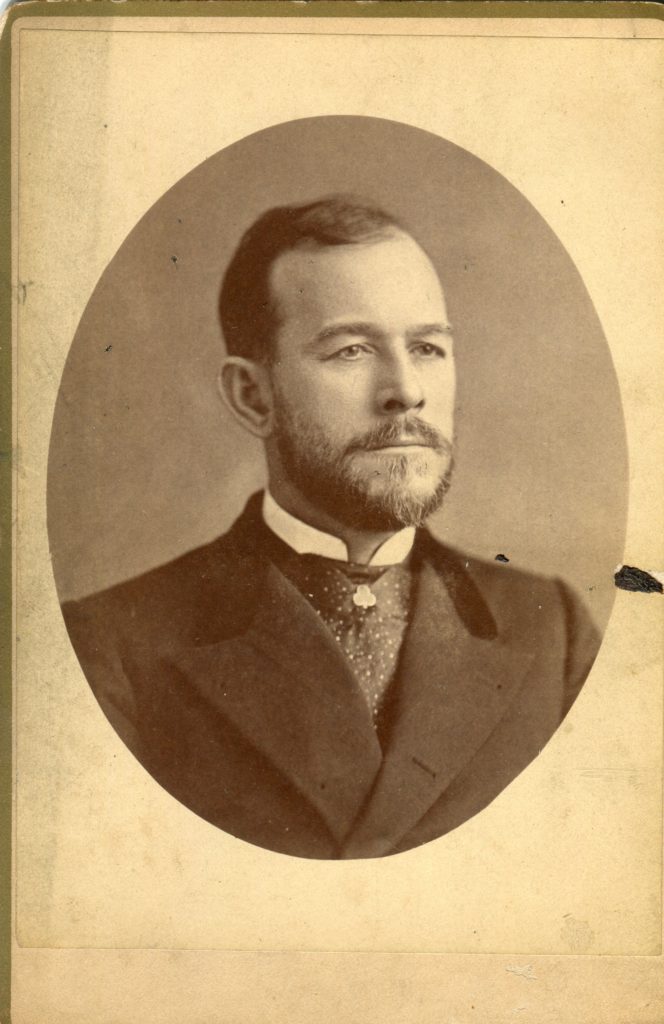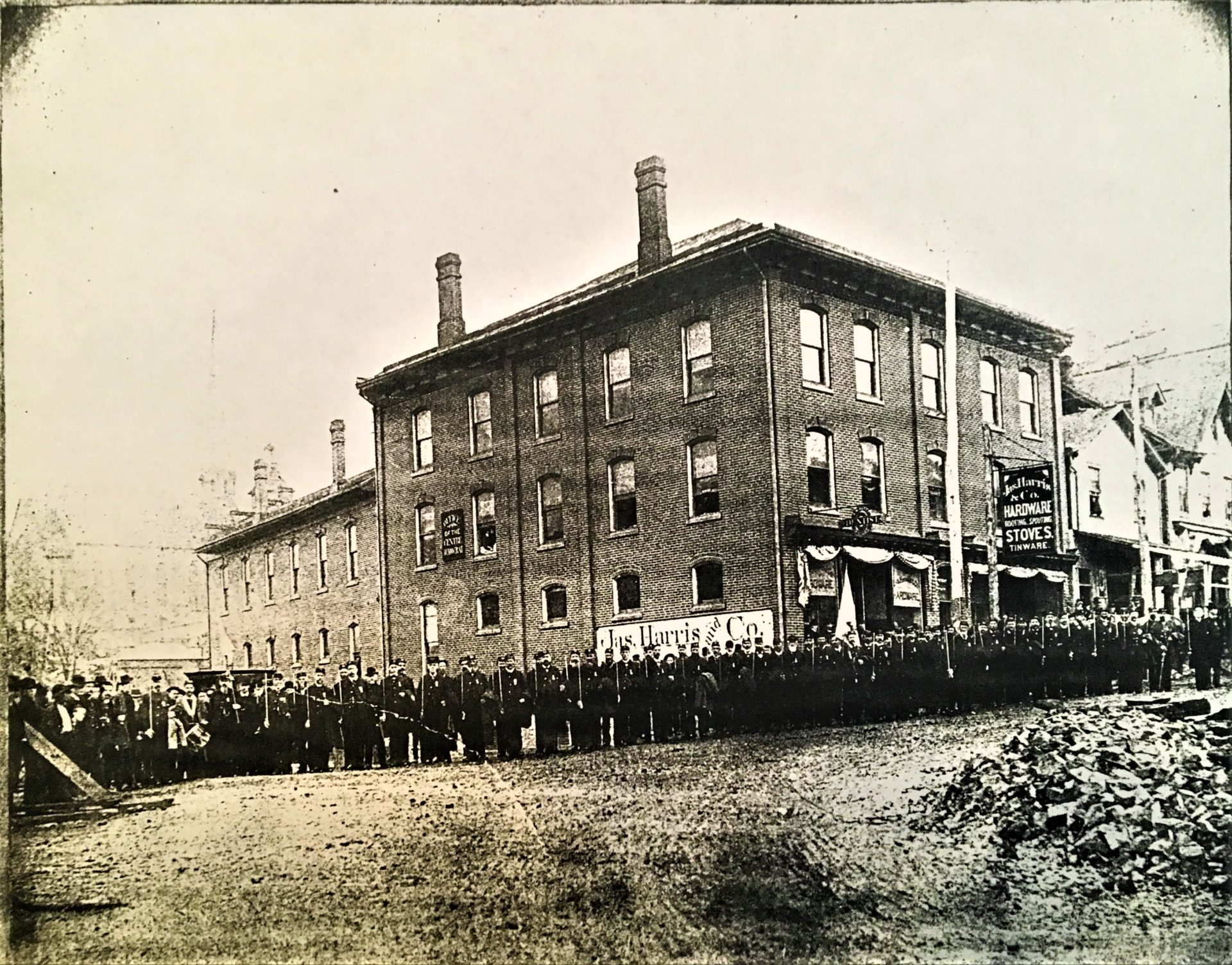At the intersection on West High Street near what is now appropriately named Veterans Bridge in Bellefonte, a group of Civil War veterans in the Grand Army of the Republic were photographed circa 1895. The following is a brief sketch in honor of those veterans and units from Centre County who served during the Civil War, veterans who returned, like those standing in the photo, and those who never came home.
On the third floor of the James Harris Hardware building was Gregg Post 95. There comrades held monthly “Camp Fire” meetings. On special occasions the veterans would dress in uniform, like when the Soldiers and Sailors Memorial was dedicated in 1906, honoring at least 3,800 names of veterans from all over Centre County. They would attend parades, reunions, or funerals for fellow soldiers, or travel to Fourth of July celebrations, often held in Gettysburg. After this photo was taken, the veterans may have traveled by train to an annual encampment meeting.
Gregg Post 95 is said to be named for either James Potter Gregg or Theodore Gregg, and generally for both, who served in the 45th Pa. Volunteers. James Potter Gregg was a physician from Milesburg who volunteered to serve at the front and drowned during the Battle of Poplar Spring Church (Peebles’ Farm). Colonel Theodore Gregg led a heroic charge at the Battle of the Crater (Petersburg). Coal miners from Pennsylvania tunneled under the Confederate lines and placed 500 kegs of black powder. The scheme infamously backfired. Inside that crater was one of the bloodiest hand-to-hand struggles of the war. Colonel Gregg fought off three enemy officers courageously, one of the Virginians surrendering his sword to Gregg.

Corporal Franklin Hogan, from Howard, Pennsylvania, was in that same crater and received the Medal of Honor “for extraordinary heroism on 30 July 1864, while serving with Company A, 45th Pennsylvania Infantry, in action at Petersburg, Virginia, for capture of flag of 6th Virginia Infantry.” Gregg and Hogan fought valiantly, but the attack was unsuccessful. A few months later, soldiers in the 148th would vote for president in the same trenches at Petersburg: 127 ballots for Lincoln, 72 for McClellan.
Volunteers answered the call from all over the county. Seventy-two men were sworn in outside the Rebersburg Hotel into Company A of the 148th Pa. Volunteers, the “Centre County Regiment.” Apparently, the officer from Harrisburg had a few too many drinks. He attempted to stand on a stone to administer the oath but had to be propped up by others. The small stone is still next to the monument today. The young men took the oath and left Brush Valley for Camp Curtin. Gov. Andrew Gregg Curtin would often visit the “boys in blue” in Harrisburg before they deployed out to become hardened veterans.

According to historian Hugh Manchester, the first casualty in the Civil War from Centre County was Charles H. Winter. Charles was a member of the Kate Curtin Guards out of the Potters Mills. Charles was brought home, but his funeral was interrupted when the Rebersburg schoolhouse burned down. Winter was only one of many who did not survive. Those who did, like General James Beaver, the namesake of Beaver Stadium, made sure their comrades were not forgotten. Beaver helped select and dedicate the Soldiers and Sailors Memorial to honor the veterans of Centre County. Beaver started as a lieutenant in the Bellefonte Fencibles, reenlisted in the 45th, then transferred to the 148th. The 25-year-old colonel commanded 1,000 until losing his leg at the Battle of Reams Station in 1864. After the war, General Beaver attended those Camp Fire meetings in the G.A.R. Hall in Bellefonte. The G.A.R. even helped pay for the burial of some of their own. Soldiers Circle in Union Cemetery is a fitting reminder of how important those Camp Fires were.
Sources:
Manchester, Hugh. “The Big Spring: Of Those Who Left to Fight.” Centre Daily Times (State College, PA), Jan. 26, 1991.
Montgomery, Dot. “Civil War Battles Brought to Life.” Mid-Stater 82, (April 24, 1976).
Muffly, J. W., Ed. The Story of Our Regiment: A History of the 148th Pennsylvania Vols., written by the comrades. Des Moines, Iowa. The Kenyon printing & mfg. co., 1904.




